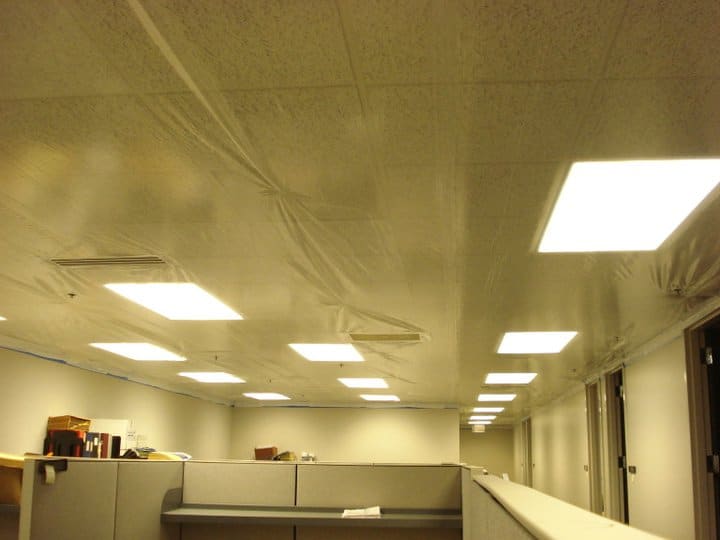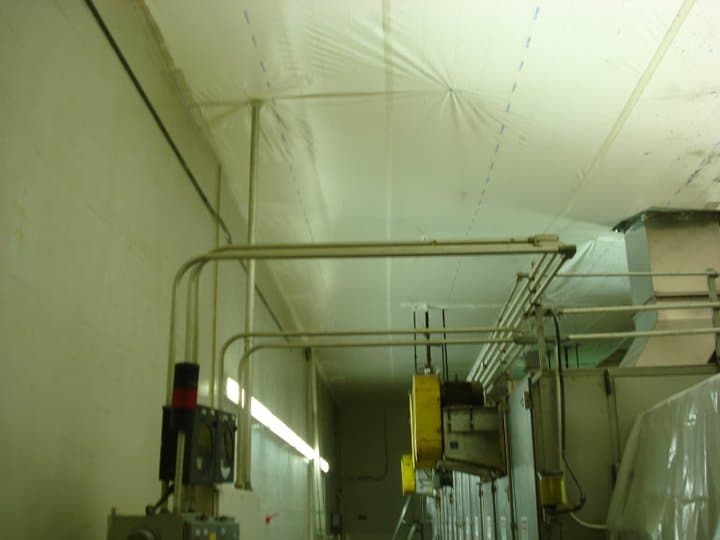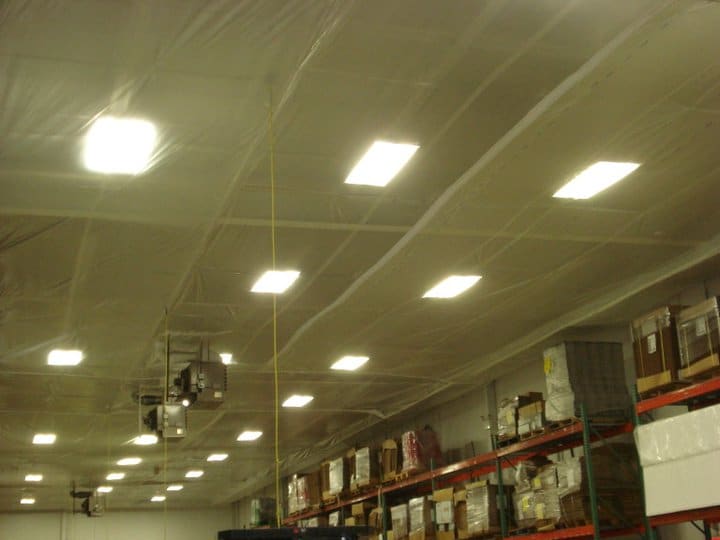The Cost of Interior Protection
The Cost of Interior Protection
by Dawn Nemelka, President of CLEANWRAP Interior Protection Systems
 Each year many facilities re-roof a section of their building as part of their annual operations & maintenance budget. I’d like to discuss several factors regarding the cost of interior protection of buildings from falling dust & interior debris protection, i.e. debris created from a re-roofing project.
Each year many facilities re-roof a section of their building as part of their annual operations & maintenance budget. I’d like to discuss several factors regarding the cost of interior protection of buildings from falling dust & interior debris protection, i.e. debris created from a re-roofing project.
The first question we typically get asked is, “How much does interior protection of a construction cost?” The simple answer is, “On average, Interior Protection costs $1.50 per square foot.” The real answer is, “It depends.” Ninety percent of interior dust and debris containment jobs cost between $1.00 – $2.00 per square foot. Many factors determine the final price. If you are looking for a budget number or an allowance number, then here are a few of the main questions we typically ask to find out the details needed to estimate the actual cost:
Level of Difficulty – How high in the air is the Temporary Suspended Ceiling going to be installed? Are we installing the poly above or below the lights? How many penetrations? Do you have digital pictures of the area that we can look at?
Accessibility – What lifts are necessary – scissor lifts or articulating boom lifts? Can we drive the lifts up and down the aisles of the facility? Can we reach everything from a lift or do we need ladders and scaffolding? Is the floor concrete, carpet, or wood?
Work Hours – What hours are we allowed into the location to work? Is this third shift work through the night or are we working weekdays during a shutdown? Are we limited to weekends or can we work continuous days? Will the machinery be operating & will production be running?
Travel & Logistics – Where is this job site located? Can we find fair-priced lodging for the install crew in the area? How many hours of travel to and from the job? How many mobilizations – can we complete this job in one trip or will we be required to travel back and forth multiple times to complete the job?
Miscellaneous – Are there any special conditions that need to be considered? Which material: Clear or with additives such as Fire Retardant or Anti-Static? Who will be providing the dumpsters to dispose of the poly after takedown?
There are many factors to consider when determining the final price. By answering a few questions and seeing some digital pictures of the areas needing protection, we can usually estimate a fairly accurate square foot price. To obtain a final number – a rock-solid price – one of our estimators will most likely have to visit the facility to verify the measurements and take a look firsthand. (This is typically done free of charge, so feel free to contact/call CLEANWRAP Interior Protection and schedule a time for a visit.)
 The costs of NOT implementing any type of Interior Protection could be higher than you think. What could it cost you, your company, or the client, if you do not propose to contain the dust and debris caused by a re-roofing project with a Temporary Interior Protection System? If you are a roofing consultant or a roofing contractor then it could cost you the job! Imagine if you submit your bid proposal for a job to the key decision makers and you did not recommend or mention Interior Protection, and your competition did. When your competition talks about it, discusses it, and provides an option for the potential problem and you do not…then isn’t it possible that your competitor appears more qualified and it may look as if you missed something? There is no cost to you to include the option of Interior Protection, no cost to include an allowance amount – even if Interior Protection was not in the specs. This one additional item may set you apart from your competition.
The costs of NOT implementing any type of Interior Protection could be higher than you think. What could it cost you, your company, or the client, if you do not propose to contain the dust and debris caused by a re-roofing project with a Temporary Interior Protection System? If you are a roofing consultant or a roofing contractor then it could cost you the job! Imagine if you submit your bid proposal for a job to the key decision makers and you did not recommend or mention Interior Protection, and your competition did. When your competition talks about it, discusses it, and provides an option for the potential problem and you do not…then isn’t it possible that your competitor appears more qualified and it may look as if you missed something? There is no cost to you to include the option of Interior Protection, no cost to include an allowance amount – even if Interior Protection was not in the specs. This one additional item may set you apart from your competition.
What could happen if a Roofing Consultant chooses not to point out the need for Interior Protection? My partner and spouse, Mark Nemelka, and I have done a lot of traveling over the past few years visiting Roofing Contractors, Roofing Consultants, and facilities. Mark has traveled over two hundred thousand miles in the past four years in dozens of states educating the commercial roofing industry about Dust & Debris Containment. You may remember one or both of us visiting your office. We have met a large number of professional Roofing Consultants and Roofing Contractors who think that Interior Protection is not their problem and that the inside is the responsibility of the owner. I really was shocked to learn they do not want to deal with it.
It has been interesting for me to learn there are roofing veterans who say they have never heard of Interior Protection and that they have never run into the need for dust and debris containment “in 30+ years of commercial roofing!” It is true that typically in the past Interior Dust and Debris Protection have been needed in about 1 out of 100 commercial roofing projects. Times are changing! – We hear it more and more as companies/facilities are requiring the Roofing Contractor or Roofing Consultant to include interior protection before the roofing begins.
If dust and debris contaminate the inside of the building, who is the facility going to blame? They’ll definitely ask, “How come the Roofer/Consultant/Property Manager didn’t tell us about this?” It typically comes down to, “It’s the Contractor’s fault or it’s the Consultant’s fault!” If the Consultant or the Contractor fails to mention the degree of contamination that will enter the building as a result of this re-roofing project, then who is to blame?
Here is another way to look at it. Let’s say you are in charge of your facility. You are the Operations Manager, Senior Engineer, or even be the Property Manager who have been told about this potential contamination problem and you chose to do nothing about it. You ignore the warnings. The cost of interior protection could be your job! I recall Mark telling me a story about returning to one particular facility where he had previously submitted a quote. He asked, “Where are Bob and Steve?” He was told that they were gone because re-roofing debris fell inside and contaminated the product, which resulted in a forced shutdown, and the cleanup costs incurred by the company were in the hundreds of thousands of dollars.
 The simple solution would have been for Bob and Steve to roll that decision up the chain and at least give the key decision-makers at the top the opportunity to select Interior Protection. Possibly, Bob and Steve thought that by eliminating the interior protection from the bid, they could save that money as compared to investing it in the prevention of contamination. Why not offer Interior Protection as an option? Why not offer an allowance amount for Interior Protection and let the client make the decision? My suggestion to you is – – to give budget numbers and allowances for Interior Protection and High Structure Cleaning to cover yourself. I believe it can only make you look more competent that you covered all the bases.
The simple solution would have been for Bob and Steve to roll that decision up the chain and at least give the key decision-makers at the top the opportunity to select Interior Protection. Possibly, Bob and Steve thought that by eliminating the interior protection from the bid, they could save that money as compared to investing it in the prevention of contamination. Why not offer Interior Protection as an option? Why not offer an allowance amount for Interior Protection and let the client make the decision? My suggestion to you is – – to give budget numbers and allowances for Interior Protection and High Structure Cleaning to cover yourself. I believe it can only make you look more competent that you covered all the bases.
We at CLEANWRAP (CLEANWRAP Safety Advisory Board) have researched hundreds of websites for commercial roofing contractors and roofing consultants and we have found only two that mention Interior Protection on their website. Is this possible that only two commercial roofing professionals in the United States talk about what they are doing to protect the inside of their building, the employees that work there, and the public who visit? The cost of not bringing it up, and the cost of not providing the option could be higher than you think. Interested in partnering with CLEANWRAP and provide Interior Protection options to your clients? Please feel free to contact us.
Dawn Nemelka
President
(888)597-3334
[email protected]


